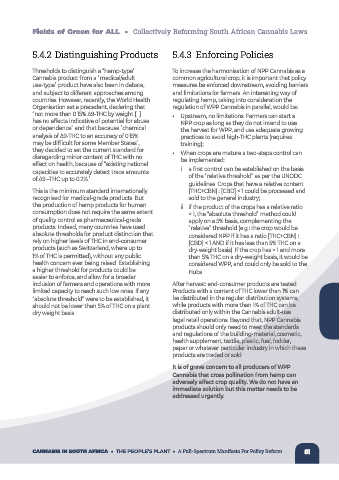Page 125 - Daggabay Magazine Issue 9
P. 125
Fields of Green for ALL • Collectively Reforming South African Cannabis Laws
5.4.2 Distinguishing Products 5.4.3 Enforcing Policies
Thresholds to distinguish a “hemp-type” To increase the harmonisation of NPP Cannabis as a
Cannabis product from a “medical/adult common agricultural crop, it is important that policy
use-type” product have also been in debate, measures be enforced downstream, avoiding barriers
and subject to different approaches among and limitations for farmers. An interesting way of
countries. However, recently, the World Health regulating hemp, taking into consideration the
Organisation set a precedent, declaring that regulation of WPP Cannabis in parallel, would be:
“not more than 0.15% ∆9-THC by weight [...] • Upstream, no limitations. Farmers can start a
has no effects indicative of potential for abuse NPP crop as long as they do not intend to use
or dependence” and that because “chemical the harvest for WPP, and use adequate growing
analysis of ∆9-THC to an accuracy of 0.15% practices to avoid high-THC plants (requires
may be difficult for some Member States”, training);
they decided to set the current standard for • When crops are mature a two-steps control can
disregarding minor content of THC with no be implemented:
effect on health, because of “existing national
capacities to accurately detect trace amounts i. a first control can be established on the basis
of ∆9 –THC up to 0.2%.” of the “relative threshold” as per the UNODC
guidelines. Crops that have a relative content
This is the minimum standard internationally [THC+CBN] : [CBD] < 1 could be processed and
recognised for medical-grade products. But sold to the general industry;
the production of hemp products for human ii. if the product of the crops has a relative ratio
consumption does not require the same extent > 1, the “absolute threshold” method could
of quality control as pharmaceutical-grade apply on a 5% basis, complementing the
products. Indeed, many countries have used “relative” threshold (e.g.: the crop would be
absolute thresholds for product distinction that considered NPP if it has a ratio [THC+CBN] :
rely on higher levels of THC in end-consumer [CBD] < 1 AND if it has less than 5% THC on a
products (such as Switzerland, where up to dry-weight basis). If the crop has > 1 and more
1% of THC is permitted), without any public than 5% THC on a dry-weight basis, it would be
health concern ever being raised. Establishing considered WPP, and could only be sold to the
a higher threshold for products could be Hubs.
easier to enforce, and allow for a broader
inclusion of farmers and operations with more After harvest: end-consumer products are tested.
limited capacity to reach such low rates. If any Products with a content of THC lower than 1% can
“absolute threshold” were to be established, it be distributed in the regular distribution systems,
should not be lower than 5% of THC on a plant while products with more than 1% of THC can be
dry weight basis. distributed only within the Cannabis adult-use
legal retail operations. Beyond that, NPP Cannabis
products should only need to meet the standards
and regulations of the building-material, cosmetic,
health supplement, textile, plastic, fuel, fodder,
paper or whatever particular industry in which these
products are traded or sold.
It is of grave concern to all producers of WPP
Cannabis that cross pollination from hemp can
adversely affect crop quality. We do not have an
immediate solution but this matter needs to be
addressed urgently.
CANNABIS IN SOUTH AFRICA • THE PEOPLE’S PLANT • A Full-Spectrum Manifesto For Policy Reform 81

